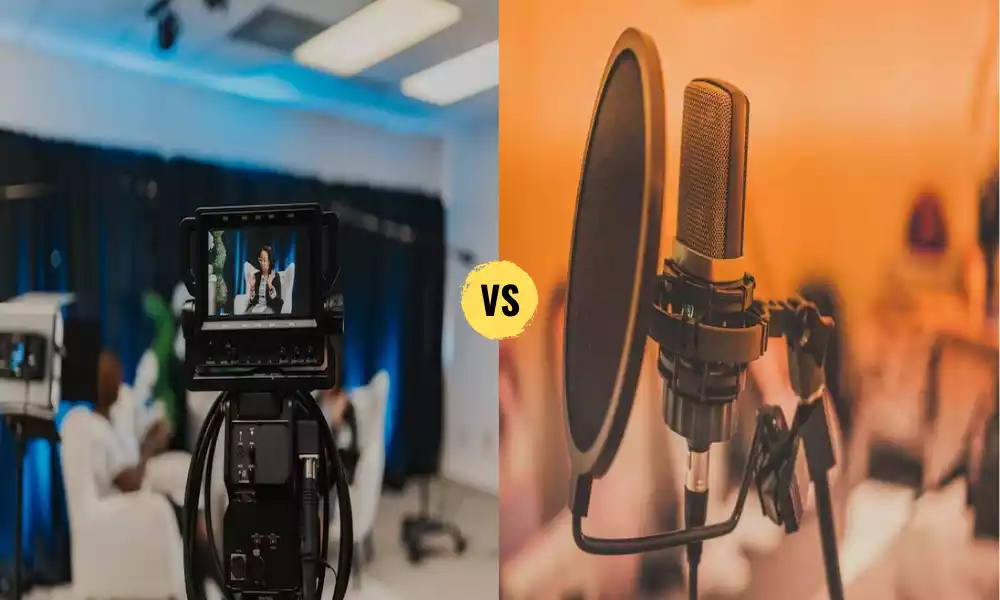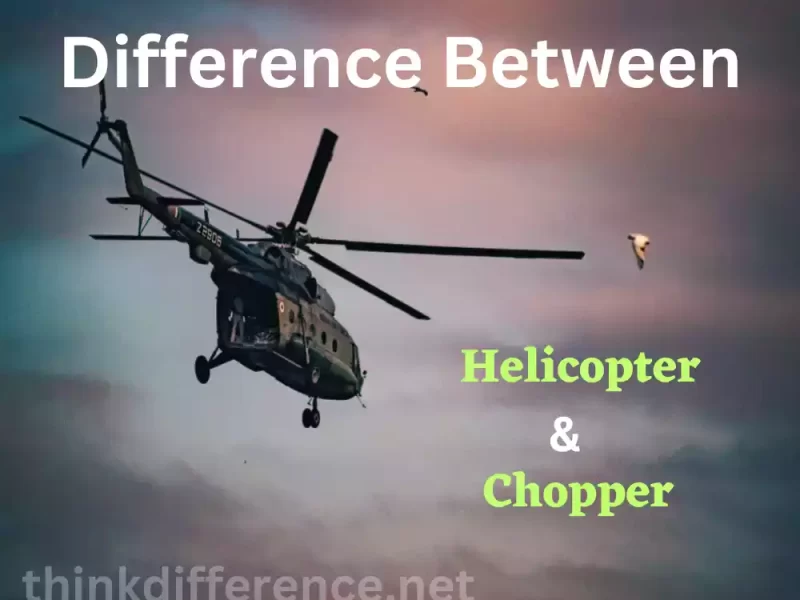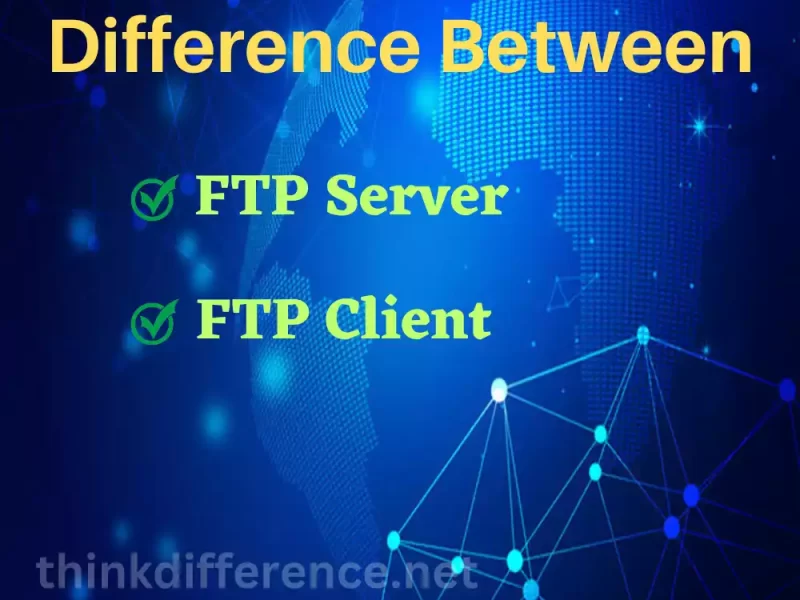Webcast and Podcast are two distinct digital media formats that have gained significant popularity in the age of digital content consumption. Webcasts are live or pre-recorded video or audio broadcasts, often used for real-time communication, webinars, conferences, or corporate events.
On the other hand, Podcasts are on-demand, audio-only, or multimedia recordings that users can subscribe to and listen to at their convenience, covering a wide range of topics from entertainment to education. Understanding the differences between these formats is crucial for content creators and consumers seeking the most suitable medium for their needs.
What is Webcast?
A webcast, short for “web broadcast,” is a digital media format used to transmit live or pre-recorded audio and/or video content over the internet. Webcasts are typically used for real-time communication, events, presentations, or broadcasts that can be accessed by a remote audience.

Key characteristics of webcasts include:
-
- Live or Pre-recorded: Webcasts can be either live broadcasts, where the content is transmitted in real-time, or pre-recorded, allowing viewers to access the content at their convenience.
- Multimedia: Webcasts can include a combination of audio and video elements, making them suitable for various purposes, from webinars and conferences to entertainment and news broadcasts.
- Streaming: Webcast content is delivered over the internet via streaming technology, allowing viewers to watch or listen as the data is transmitted, rather than downloading large files.
- Interactivity: Depending on the platform and technology used, webcasts may offer interactive features, such as live chat or Q&A sessions, enabling real-time engagement between presenters and the audience.
- Use Cases: Webcasts are commonly used for corporate events, product launches, educational webinars, live sports events, virtual conferences, and other situations where real-time communication and engagement are important.
- Accessibility: They can be accessed by a wide audience with an internet connection and compatible devices, making them a versatile tool for reaching a global audience.
Webcasts play a crucial role in disseminating information, facilitating remote collaboration, and engaging audiences in various fields, including business, education, entertainment, and more.
What is Podcast?
A podcast is a digital media format that primarily involves audio recordings, although it can also include video content. Podcasts are typically episodic and are made available for on-demand listening or viewing.

Here are the key characteristics of podcasts:
-
- Audio-Centric: While podcasts can include video, the primary focus is on audio content. They are often in the form of spoken conversations, interviews, storytelling, or discussions on a wide range of topics.
- Episodic: Podcasts are organized into episodes, making it easy for listeners to follow a series or subscribe to a particular show. New episodes are regularly released, creating a sense of anticipation among the audience.
- On-Demand: Unlike live broadcasts, podcasts can be accessed at any time, allowing listeners to choose when and where they want to consume the content. This flexibility is one of the defining features of podcasts.
- Subscription-Based: Podcasts are typically distributed via RSS feeds, and listeners can subscribe to their favorite shows using podcast apps or software. Subscribing ensures that new episodes are automatically downloaded or made available for streaming when they are released.
- Diverse Content: Podcasts cover a wide array of topics, including news, storytelling, education, entertainment, self-help, technology, and more. This diversity of content has contributed to the popularity of podcasts across various niches.
- Accessibility: Podcasts can be accessed on computers, smartphones, tablets, and other portable devices with internet connectivity, making them highly accessible to a broad audience.
- Independent Production: Many podcasts are produced independently by individuals or small teams, allowing for a diverse range of voices and perspectives. There are also professionally produced podcasts by major media organizations and companies.
- Community and Engagement: Podcasts often build dedicated communities of listeners who engage with the content and creators through social media, listener feedback, and reviews.
Podcasts have become a powerful medium for storytelling, education, entertainment, and information dissemination. They offer a unique platform for creators to share their expertise, experiences, and passions with a global audience, and listeners can engage with content that aligns with their interests and schedules.
Comparison Table of Webcast and Podcast
Here’s a comparison table highlighting the key differences between webcasts and podcasts:
| Aspect | Webcast | Podcast |
|---|---|---|
| Content Type | Live or pre-recorded audio/video broadcasts | Pre-recorded audio content (may include video) |
| Timing | Real-time or scheduled broadcasts | On-demand; available anytime |
| Interaction | Real-time audience interaction (e.g., Q&A, chat) | Limited audience interaction, usually via comments or social media |
| Subscription | Typically not subscribed to; viewers join live events | Subscribed to by users for automatic updates |
| Purpose | Live events, webinars, conferences, corporate communications | Storytelling, education, entertainment, news, interviews, discussions |
| Accessibility | Requires internet access during the live event | Content can be downloaded and accessed offline once downloaded |
| Multimedia | Often includes video and audio elements | Primarily audio, but may include video |
| Engagement | Real-time engagement with the audience | Engagement usually occurs asynchronously |
| Length | Varies widely, from minutes to hours | Typically shorter, often ranging from a few minutes to an hour or more |
| Production | May involve larger production teams and equipment | Produced by individuals or smaller teams |
| Examples | Live sports broadcasts, webinars, virtual conferences | The Joe Rogan Experience, The Daily, How I Built This |
| Accessibility Devices | Computers, smartphones, tablets, smart TVs | Computers, smartphones, tablets, dedicated podcast apps |
| Distribution Platforms | Streaming platforms, websites, social media | Podcast directories, apps (e.g., Apple Podcasts, Spotify) |
| Portability | Less portable due to live nature | Highly portable, can be listened to offline |
| Real-Time vs. On-Demand | Real-time communication | Asynchronous, on-demand consumption |
This table highlights the primary distinctions between webcasts and podcasts in terms of content type, timing, interaction, subscription, purpose, accessibility, multimedia elements, engagement, length, production, examples, and distribution platforms. Understanding these differences is essential for content creators and consumers when deciding which format best suits their needs and preferences.
Similarities of Webcast and Podcast
While webcasts and podcasts are distinct in many ways, they also share several similarities:
- Online Distribution: Both webcasts and podcasts are distributed and accessed over the internet. They leverage digital technology to reach a wide and often global audience.
- Broad Audience Reach: Both formats have the potential to reach a large and diverse audience. They are not limited by geographical boundaries and can attract listeners or viewers from around the world.
- Subscription Options: Some webcast platforms offer subscription options, allowing users to subscribe to channels or specific webcast series. Similarly, podcasts rely on subscriptions to notify listeners of new episodes automatically.
- Multimedia Potential: While podcasts are primarily audio-focused, they can include video elements. Conversely, webcasts, though predominantly live video broadcasts, can incorporate audio components. This multimedia potential provides content creators with flexibility in their storytelling or communication methods.
- Content Variety: Both webcasts and podcasts cover a wide range of topics and genres. They are used for entertainment, education, news, interviews, discussions, and more, catering to various interests and niches.
- Accessibility and Convenience: Both formats are accessible on a variety of devices, including computers, smartphones, tablets, and smart TVs. They offer the convenience of listening or viewing content on the go and can be consumed at the user’s preferred pace.
- Engagement and Community Building: Webcasts and podcasts often foster engagement and community-building. Viewers and listeners can interact with content creators through comments, reviews, social media, or dedicated online communities.
- Independent Production: Many webcasts and podcasts are produced independently or by smaller teams. This independence allows for a diverse range of voices and perspectives in both formats.
- Content Archives: Both webcasts and podcasts typically maintain archives of past episodes or broadcasts, allowing users to access older content at any time.
While webcasts and podcasts differ in their real-time vs. on-demand nature and their primary medium (live video vs. audio), these shared characteristics demonstrate the broader impact and versatility of digital media in today’s content landscape.
The Impact of Webcasts and Podcasts
The impact of webcasts and podcasts on various aspects of society, communication, and entertainment has been significant. These digital media formats have transformed the way information is disseminated, consumed, and interacted with.
Here are some key impacts of webcasts and podcasts:
- Information Accessibility: Webcasts and podcasts have democratized information dissemination. They provide a platform for individuals and organizations to share knowledge, news, and stories with a global audience. This accessibility has empowered people to access niche content that may not be available through traditional media channels.
- Education and Training: Webcasts and podcasts have become valuable tools for education and training. Educational institutions, businesses, and experts use these formats to deliver lectures, workshops, and tutorials. This accessibility to educational content has expanded learning opportunities for people of all backgrounds.
- Remote Collaboration: Webcasts enable real-time remote collaboration, making it easier for businesses to conduct meetings, seminars, and conferences across different geographical locations. This has become particularly important in the context of remote work and global connectivity.
- Corporate Communication: Companies utilize webcasts for internal and external communications. They can address employees, shareholders, and customers directly, enhancing transparency and engagement. This has proven vital during times of crisis or major announcements.
- Entertainment and Media: Podcasts have disrupted the entertainment and media industry. They offer a platform for storytellers, comedians, musicians, and content creators to reach and connect with their audiences directly. Podcasts have given rise to new forms of entertainment and cultural phenomena.
- Journalism and News: Podcasts have expanded the reach of journalism and news reporting. Many news outlets produce podcasts to offer in-depth analysis, interviews, and alternative perspectives. This format has also allowed independent journalists to share their investigative work and opinions.
- Community Building: Webcasts and podcasts often foster communities around specific interests, passions, or fandoms. Engaged listeners and viewers come together to discuss content, share insights, and create a sense of belonging.
- Monetization Opportunities: Creators and businesses can monetize webcasts and podcasts through advertising, sponsorships, premium content, merchandise, and crowdfunding. This has enabled content creators to generate income and sustain their productions.
- Personal Development: Podcasts, in particular, have become a valuable resource for personal development. They offer self-help, motivational, and self-improvement content that can inspire and educate listeners.
- Political and Social Impact: Webcasts and podcasts have played a role in shaping political and social discourse. They provide platforms for discussions on important issues, and grassroots movements often use these formats to mobilize support and raise awareness.
- Diverse Voices: These formats have allowed underrepresented and marginalized voices to be heard. Podcasting, in particular, has given a platform to individuals and communities whose stories may not have been widely shared through traditional media.
- Innovation: The growth of webcasts and podcasts has spurred technological innovation in areas such as streaming technology, podcast hosting platforms, and podcast monetization strategies.
Webcasts and podcasts have democratized content creation and consumption, offering a diverse array of voices and perspectives while reshaping industries, communication, and entertainment in the digital age. Their impact is likely to continue evolving as technology and audience preferences evolve.
Emerging Trends in the World of Webcast and Podcast
As of my last knowledge update in September 2021, the world of webcasts and podcasts was constantly evolving with emerging trends and developments. While I can’t provide information on events or trends that have emerged after that date.
Here are some trends that were gaining momentum in the world of webcasts and podcasts up to that point:
Live Streaming and Webinar Integration: Webcasts were increasingly being used for live streaming and webinars, especially in the business and education sectors. Organizations were harnessing the power of real-time interaction and engagement to connect with their audiences, employees, or students.
Interactive Features: Both webcasts and podcasts were incorporating more interactive elements. For webcasts, this meant live chat, Q&A sessions, and audience polls. Podcasts were experimenting with interactive storytelling and engaging with listeners through social media and online communities.
Podcast Monetization: Podcasters were exploring various monetization models beyond traditional advertising, including subscription-based content, exclusive content for paid subscribers, merchandise sales, and crowdfunding through platforms like Patreon.
Niche Content: There was a growing trend toward niche content in both webcasts and podcasts. Creators were focusing on specialized topics and catering to highly targeted audiences. This niche approach allowed for deeper engagement and more dedicated listener/viewer bases.
Podcast Networks: Podcast networks and production companies were forming to support creators with resources, marketing, and distribution. These networks aimed to elevate the quality and visibility of podcasts, much like traditional television or radio networks.
Immersive Audio: Podcasts were experimenting with immersive audio experiences, such as binaural recordings and 3D audio, to create more engaging and immersive storytelling.
Accessibility and Inclusivity: There was a growing awareness of the need for better accessibility in both webcasts and podcasts. Creators were making efforts to provide transcripts, captions, and other accessibility features to reach a wider audience.
AI and Personalization: Some podcast platforms and apps were using AI to recommend content to users based on their preferences and listening habits. This personalized approach aimed to keep listeners engaged and discover new content.
Remote Production: The COVID-19 pandemic accelerated the adoption of remote production techniques for both webcasts and podcasts. Remote recording and collaboration tools became essential for content creators.
International Expansion: Podcasts, in particular, were expanding to reach global audiences. Creators were localizing content and exploring ways to connect with listeners in different regions and languages.
These tendencies are based on information available as of September 2021. The landscape of webcasts and podcasts may have continued to evolve with new technologies and innovations since then. To get the most up-to-date information on emerging trends, it’s recommended to consult industry publications and news sources in the field.
Challenges and How to Overcome Them
Challenges in the world of webcasts and podcasts can vary depending on the specific context and goals of content creators and organizations. Here are some common obstacles and how they can be overcome:
1. Content Quality and Production:
- Challenge: Maintaining high-quality content, especially for those with limited resources or technical expertise.
- Solution:
- Invest in quality recording equipment and editing software.
- Train team members or consider outsourcing production to experts.
- Focus on content planning and scripting to ensure engaging and informative material.
2. Finding and Growing an Audience:
- Challenge: Attracting and retaining listeners or viewers in a competitive space.
- Solution:
- Research your ideal audience and create content that resonates with them.
- Use effective marketing strategies, including social media, email newsletters, and SEO optimization.
- Collaborate with influencers or other podcasters/webcasters to expand your reach.
3. Monetization:
- Challenge: Generating income from your content, especially if you rely on it as a primary source of income.
- Solution:
- Explore multiple monetization avenues, such as advertising, sponsorships, merchandise, premium content, or crowdfunding.
- Build a dedicated and engaged audience to attract advertisers and sponsors.
4. Technical Issues:
- Challenge: Dealing with technical glitches, internet connectivity problems, or equipment failures.
- Solution:
- Invest in reliable equipment and have backup options in place.
- Perform regular technical checks before recording or going live.
- Have technical support or troubleshooting resources available.
5. Consistency and Burnout:
- Challenge: Maintaining a regular content schedule without experiencing burnout.
- Solution:
- Create a content calendar and plan episodes or webcasts in advance.
- Delegate tasks and responsibilities if you’re part of a team.
- Take breaks as necessary and prioritize self-care in order to avoid burnout.
6. Copyright and Legal Issues:
- Challenge: Avoiding copyright infringement and navigating legal complexities.
- Solution:
- Be familiar with copyright laws and fair usage principles to avoid problems of copyright
- Violations and utilize royalty-free images and music as much as possible to stay out of trouble.
- Seek legal advice if necessary and consider obtaining licenses for copyrighted material.
7. Engaging Content:
- Challenge: Ensuring your content remains engaging and relevant to your audience.
- Solution:
- Collect feedback from your audience and adjust content accordingly.
- Stay abreast of recent trends and upcoming news in your field.
- Experiment with different formats and storytelling techniques.
8. Financial Sustainability:
- Challenge: Ensuring that your webcast or podcast remains financially sustainable.
- Solution:
- Diversify your revenue sources to reduce dependence on one source.
- Create a business plan and budget to manage expenses effectively.
- Explore partnerships or collaborations to share costs and resources.
9. Accessibility and Inclusivity:
- Challenge: Ensuring that your content is accessible to all, including individuals with disabilities.
- Solution:
- Provide captions and transcripts for video and audio content.
- Use alt text for images and descriptions for visual content.
- Regularly audit your content for accessibility compliance.
10. Staying Informed:
- Challenge: Keeping up with the evolving trends, technologies, and best practices in the field.
- Solution:
- Subscribe to industry newsletters and podcasts/webcasts.
- Attend conferences, webinars, and workshops.
- Network with other content creators to share knowledge and insights.
Overcoming challenges in the world of webcasts and podcasts often requires a combination of technical expertise, strategic planning, creativity, and adaptability. It’s essential to continuously learn, iterate, and refine your approach as you navigate these challenges in your content creation journey.
Future of Webcasts and Podcasts
The future of webcasts and podcasts is likely to be shaped by evolving technology, changing audience preferences, and emerging trends. While I can’t predict specific developments beyond my last knowledge update in September 2021,
I can provide insights into potential directions for these digital media formats:
Enhanced Interactivity: Both webcasts and podcasts may incorporate more interactive elements to engage audiences. This could include live polls, audience participation, virtual reality (VR) experiences, or even interactive storytelling techniques.
Improved Accessibility: There will likely be a continued emphasis on making content more accessible to diverse audiences, including individuals with disabilities. Innovations in AI and machine learning may lead to more sophisticated captioning, transcription, and translation services.
Personalization: Technology may enable greater personalization of content, tailoring webcasts and podcasts to individual preferences. AI-driven recommendations and content curation could become more sophisticated.
Integration with Other Media: Webcasts and podcasts may increasingly integrate with other forms of media, such as social media platforms, augmented reality (AR), and video streaming services, allowing for cross-platform engagement.
Monetization Models: Creators and platforms may continue to experiment with new monetization models beyond advertising and subscriptions. NFTs (non-fungible tokens) and blockchain technology might be explored for content ownership and monetization.
Expansion of Virtual Events: Webcasts may continue to play a vital role in virtual events, offering immersive experiences for conferences, trade shows, and entertainment events. Hybrid events that combine virtual and in-person elements may become more common.
Voice Technology: As voice assistants and smart speakers become more prevalent, voice-activated access to webcasts and podcasts could increase. Creators may optimize content for voice search and voice-controlled devices.
Artificial Intelligence: AI could be used to automate content production, from transcription and editing to generating summaries and highlights. This could streamline the production process and enhance content quality.
Diverse Voices and Perspectives: Efforts to include underrepresented voices and diverse perspectives in content creation may intensify, leading to a broader range of voices and stories in both webcasts and podcasts.
Regulation and Ethics: As these formats gain more prominence, there may be increased scrutiny and regulation, particularly around issues like misinformation, data privacy, and content moderation. Ethical considerations in content creation and distribution may become more critical.
Global Expansion: Webcasts and podcasts have the potential to reach even wider global audiences. Content creators may produce content in multiple languages to cater to diverse regions and cultures.
Sustainability: Environmental concerns may lead to more sustainable practices in content production, such as reducing carbon footprints associated with data centers and streaming.
The future of webcasts and podcasts will likely be marked by innovation, diversification, and continued adaptation to the changing media landscape. Creators and platforms that stay agile, embrace emerging technologies, and prioritize audience needs are likely to thrive in this evolving landscape.
Final Thoughts
Webcasts and Podcasts are two dynamic digital media formats that have reshaped how we consume content in the digital age. Webcasts offer real-time engagement and information dissemination, while podcasts provide on-demand, highly portable audio and multimedia experiences. Both have democratized content creation, expanded educational opportunities, and fostered communities around diverse interests.
Their future holds the promise of enhanced interactivity, personalization, and continued growth as they adapt to evolving technology and audience preferences. Whether it’s live broadcasts or timeless audio stories, webcasts and podcasts have cemented their place as vital mediums for information, entertainment, and connection in the digital world.



